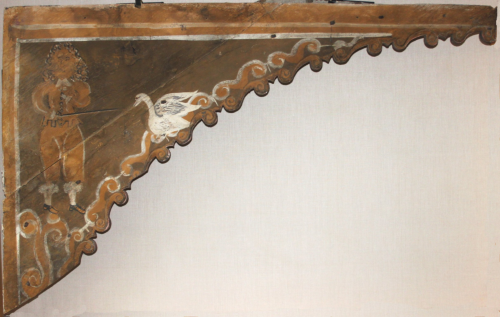

Tower and Town, July 2017 (view the full edition) (view the full edition)A Merchant's House DiscoveryShortly after the newly-formed Merchant's House Trust moved into the property at 133 High Street, the volunteers began careful exploratory uncovering of areas of wall surface. This is known as upstanding archaeology. We were fortunate that the last domestic occupancy was in the 1970s, so our surfaces were of the long tradition in which each new paper scheme was laid on top of the previous layers, thus creating an historic stratigraphy. Such a process, using the then available adhesives, were more forgiving than modern synthetic products. As the layers were peeled away, we experienced an interior-decorative time trail which started with the orange/brown pub décor styles of the nineteen-seventies. From here to the florid Victorian layers to the pre-wallpaper age where paint was the chosen surface, we dug back into history. Eventually the original, 17th century layers were revealed. This is the stuff of which architectural historians dream. The walls of the great staircase were painted in imitation of the wooden balustrading, an outstanding example of trompe l'oeil decoration, all painted in a pale grey to resemble stonework. Next the dining room was investigated. This was brilliant in every meaning of the word. Could the puritan Bayly family, builders of the house, really have indulged in such a pavonine display? Bands of coloured stripes, 13 inches wide, were spaced around the room, dazzling in their boldness. It eventually dawned on us that the family, as silk mercers, might be paying a tribute to the textile patterns with which they were familiar, or perhaps the scheme is a direct copy of a fabric in their possession, or might be the matching curtains in that very room. There was more to come, however. On the ground floor, between the shop and the side passage, layers of shop fittings and wall coverings were being removed. First the W H Smith fittings, then deal matchboarding of Lucy's the stationers, taking us back to an oak screen of about 1690. Behind this we could discern a board, mounted high on the wall and butting the ceiling beam. By touch it was found to be carved along a curved bottom profile. As the oak screen needed to be restored in a workshop environment, it was removed, and our latest discovery was revealed. Spandrel shaped, (think the comer of a clock face, filling the space between the round dial and the square corner), the elm board was a painted design showing a man and a swan. Here was a survival from Bayly's shop decoration, installed following the Great Fire of Marlborough in 1653. No human eye had seen this image since the oak screen covered it in about 1690. Our man, almost certainly the only surviving depiction of a Marlborough resident from this period, confronts the viewer whilst fending off the swan with a sword or stick. Painted in a limited palette of ochres, black, white and grey on an elm support of two boards, the technique is impressionistic in style and primitive in execution. The man's hair and costume place him firmly in the 1650s - the period of the rebuilding of Thomas Bayly's house. What a discovery - and what a mystery. How do the man and the swan relate to each other? There is one possible clue in the records of the Duke of Somerset, now held in Alnwick Castle, Northumberland: Pd Mr Tayler for looking to my Lords Swanes for marking of them. Aug. 19.1671 18. o. From this primary source it is clear that in the seventeenth century ownership of swans was not confined to the Crown, The Dyers Company and the Vintners Company, as it is today. My Lord Seymour, it seems, was regularly notching the birds' beaks in his own private swan-upping ceremony before returning them to the Kennet. Could this be the subject of our mysterious painting? For the moment I am pleased to add this probability to Marlborough's rich store of history.  Michael Gray |